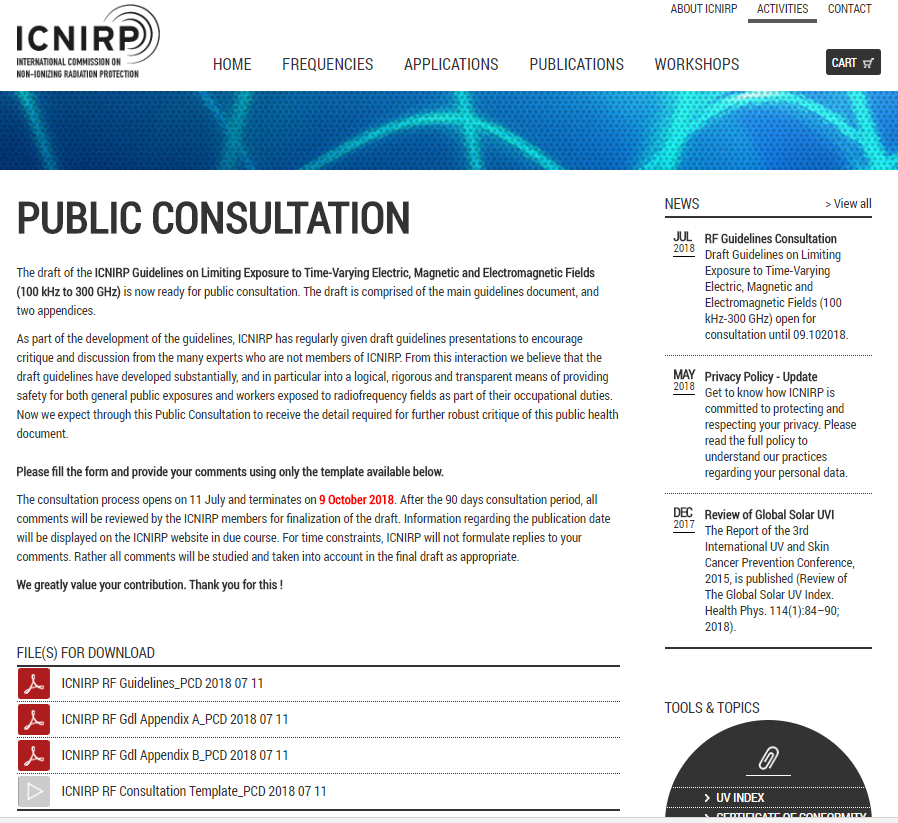Public Consultation
The draft of the ICNIRP Guidelines on Limiting Exposure to Time-Varying Electric, Magnetic and Electromagnetic Fields (100 kHz to 300 GHz) is now ready for public consultation. The draft is comprised of the main guidelines document, and two appendices.
As part of the development of the guidelines, ICNIRP has regularly given draft guidelines presentations to encourage critique and discussion from the many experts who are not members of ICNIRP. From this interaction we believe that the draft guidelines have developed substantially, and in particular into a logical, rigorous and transparent means of providing safety for both general public exposures and workers exposed to radiofrequency fields as part of their occupational duties. Now we expect through this Public Consultation to receive the detail required for further robust critique of this public health document.
Please fill the form and provide your comments using only the template available below.
The consultation process opens on 11 July and terminates on 9 October 2018. After the 90 days consultation period, all comments will be reviewed by the ICNIRP members for finalization of the draft. Information regarding the publication date will be displayed on the ICNIRP website in due course. For time constraints, ICNIRP will not formulate replies to your comments. Rather all comments will be studied and taken into account in the final draft as appropriate.
We greatly value your contribution. Thank you for this ! https://www.icnirp.org/en/activities/public-consultation/consultation-1.html
File(s) for download
ICNIRP_RF_Guidelines_PCD_2018_07_11
ICNIRP_RF_Guidelines_PCD_Appendix_A_2018_07_11(1)
ICNIRP_RF_Guidelines_PCD_Appendix_B_2018_07_11
ICNIRP_RF_PublicConsultationForm2018_07_11(3)


Added note by EMFSA: see https://www.saferemr.com/2018/07/icnirps-exposure-guidelines-for-radio.html
Editorial comments by Joel Moskowitz:
To date, 242 scientists who have published peer-reviewed research on EMF and biology or health have signed the EMF Scientist Appeal. Collectively, these scientists from 41 nations have published more than 2,000 papers on EMF. The Appeal calls on the WHO and the United Nations including its member states to adopt more protective exposure guidelines for EMF including RF radiation in the face of increasing evidence of health risks since these exposures are a rapidly growing form of worldwide environmental pollution.
In a recently published, peer-reviewed paper, “Thermal and non-thermal health effects of low intensity non-ionizing radiation: An international perspective,” Belpomme and his colleagues (2018) criticize the WHO due to its reliance upon ICNIRP and its members for expert advice. The paper claims that ICNIRP and its advisors have “close associations with industry,” and “conflicts of interest.” According to the authors, ICNIRP and its advisors have been engaged in decades of “denial of serious non-thermal effects of RF-EMFs in spite of overwhelming scientific evidence to the contrary.”
Moreover, Belpomme and his colleagues criticize ICNIRP’s safety limits:
“The specific absorption rate (SAR)-based ICNIRP safety limits were established on the basis of simulation of EMF energy absorption using standardized adult male phantoms, and designed to protect people only from the thermal effects of EMFs. These assumptions are not valid for two reasons. Not only do they fail to consider the specific morphological and bioclinical vulnerabilities of children, but also they ignore the effects known to occur at non-thermal intensities….”
Finally, Belpomme and his colleagues (2018) provide a summary of the peer-reviewed scientific literature that arrives at very different conclusions than ICNIRP’s health risk assessment:
“It is urgent that national and international bodies, particularly the WHO, take this significant public health hazard seriously and make appropriate recommendations for protective measures to reduce exposures. This is especially urgently needed for children and adolescents. It is also important that all parts of society, especially the medical community, educators, and the general public, become informed about the hazards associated with exposure to EMFs and of the steps that can be easily taken to reduce exposure and risk of associated disease.”
The rules that ICNIRP applies for a study to be included in its health risk assessment seem overly stringent. If other official bodies (e.g., the International Agency for Research on Cancer or the U.S. Environmental Protection Agency) were to adopt such rules, I suspect that very few chemicals would be classified as toxins or carcinogens. By its own admission, ICNIRP is not concerned about protecting animal or plant life from the adverse effects of EMF exposure, and it is arguable that they are truly concerned about protecting humans.
If the claims of some EMF scientists and scientific organizations (e.g., the European Cancer and Environment Research Institute and the Russian National Committee on Non-Ionizing Radiation Protection) are true that ICNIRP’s members and scientific advisors are selected because they are biased toward industry, then it is fruitless to engage in ICNIRP’s public consultation process (see my posts from May 1 through June 27, 2017.)
Since the credibility of ICNIRP depends heavily upon its association with the WHO, a more fruitful activity for the EMF scientific community might be to convince the WHO and governments not to rely on ICNIRP for EMF guidelines and no longer consult ICNIRP’s advisors.
